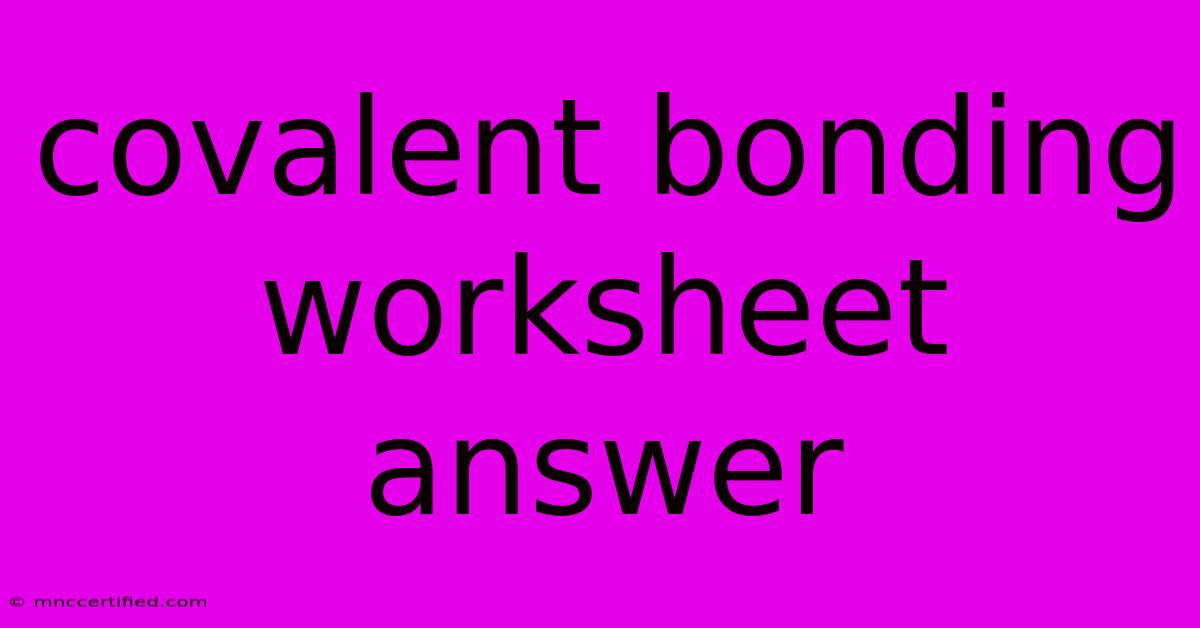Covalent Bonding Worksheet Answer

Table of Contents
Covalent Bonding Worksheet Answers: A Comprehensive Guide
Are you struggling with your covalent bonding worksheet? Don't worry, you're not alone! Covalent bonding can be a tricky concept to grasp, but with a little help and the right resources, you'll be mastering it in no time. This comprehensive guide provides answers and explanations to common covalent bonding worksheet questions, helping you solidify your understanding of this crucial chemical concept.
Understanding Covalent Bonds
Before we dive into the answers, let's quickly review the fundamentals. A covalent bond is a chemical bond formed when two atoms share one or more pairs of electrons. This sharing allows both atoms to achieve a more stable electron configuration, usually a full outer electron shell (octet rule). Unlike ionic bonds, which involve the transfer of electrons, covalent bonds result in the formation of molecules.
Key characteristics of covalent bonds:
- Electron sharing: Atoms share electrons to achieve stability.
- Nonmetals: Covalent bonds typically occur between nonmetal atoms.
- Lower melting and boiling points: Compared to ionic compounds, covalent compounds generally have lower melting and boiling points.
- Poor electrical conductivity: Covalent compounds usually do not conduct electricity in solid or liquid states.
Common Covalent Bonding Worksheet Questions & Answers
This section tackles common question types found in covalent bonding worksheets. Remember, the specific questions on your worksheet might vary, but the underlying principles remain the same.
Question Type 1: Drawing Lewis Dot Structures
Example: Draw the Lewis dot structure for water (H₂O).
Answer: Oxygen (O) has 6 valence electrons, and each hydrogen (H) has 1. The oxygen atom shares one electron pair with each hydrogen atom, forming two single covalent bonds. The Lewis dot structure would look like this:
O
/ \
H H
Key points to remember when drawing Lewis structures:
- Valence electrons: Determine the number of valence electrons for each atom.
- Octet rule: Most atoms strive to have eight electrons in their outer shell (except for hydrogen, which aims for two).
- Bonding pairs: Shared electron pairs form the bonds between atoms.
- Lone pairs: Unshared electron pairs are called lone pairs.
Question Type 2: Identifying Bond Types
Example: Identify the type of bond in carbon dioxide (CO₂).
Answer: Carbon dioxide contains double covalent bonds. The carbon atom shares two electron pairs with each oxygen atom.
Question Type 3: Predicting Molecular Geometry
Example: Predict the molecular geometry of methane (CH₄).
Answer: Methane has a tetrahedral molecular geometry. The central carbon atom is bonded to four hydrogen atoms, arranged symmetrically in a tetrahedral shape. Understanding VSEPR (Valence Shell Electron Pair Repulsion) theory is crucial for accurately predicting molecular geometry.
Question Type 4: Polarity of Covalent Bonds
Example: Is the bond between hydrogen and oxygen in water polar or nonpolar?
Answer: The bond between hydrogen and oxygen in water is polar. Oxygen is more electronegative than hydrogen, meaning it attracts the shared electrons more strongly. This creates a partial negative charge (δ-) on the oxygen and partial positive charges (δ+) on the hydrogens.
Understanding electronegativity is key to determining bond polarity.
Tips for Success with Covalent Bonding Worksheets
- Review your notes and textbook: Make sure you understand the fundamental concepts before attempting the worksheet.
- Practice, practice, practice: The more you practice drawing Lewis structures and identifying bond types, the easier it will become.
- Seek help when needed: Don't hesitate to ask your teacher or tutor for clarification if you're struggling with any questions.
- Utilize online resources: Many websites and videos offer helpful explanations and practice problems.
By carefully reviewing these examples and utilizing the provided tips, you'll significantly improve your understanding of covalent bonding and ace your next worksheet! Remember to focus on the underlying principles and practice regularly. Good luck!

Thank you for visiting our website wich cover about Covalent Bonding Worksheet Answer. We hope the information provided has been useful to you. Feel free to contact us if you have any questions or need further assistance. See you next time and dont miss to bookmark.
Featured Posts
-
Son In Laws England Goal Keanes Response
Nov 18, 2024
-
Gold Bond Commercial Actress Name
Nov 18, 2024
-
I M A Celebrity 2024 Start Time Tonight
Nov 18, 2024
-
Met Office Issues Yellow Snow Warning 10 Cities
Nov 18, 2024
-
Season Over Jones Leg Injury
Nov 18, 2024